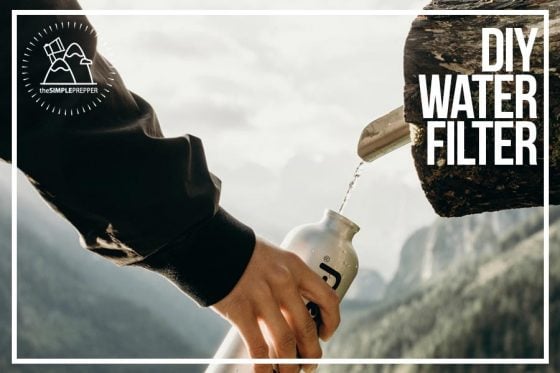This article was originally published by Prepper Aaron on The Simple Prepper.SHTFPlan republished this article on May 6th, 2019.
*EDITOR’S NOTE: This is being shared again to help those who live in areas where water is becoming scarce and foul-tasting due to droughts. My hope is that this will help at least a few people to be able to better filter their water to protect their health during increasingly crazy times.

Preppers, how do you filter water in an emergency… without a filter? Filtering water is not something most people normally spend much time thinking about – after all, the water that comes out of your sink is perfectly safe to drink. But during an emergency or in a survival situation out in the wild, you cannot take potable water for granted. In those situations, knowing how to purify water without a filter on hand or how to make a water filter in the wild can be the difference between life and death.
Thankfully, there are a number of survival water filter DIY methods that can work in a pinch and require only materials that you are likely to have on hand, around the house, or can find in the backcountry. This is a case where studying these methods a little bit ahead of time can make an enormous difference in your ability to survive in an extreme situation. Also, be sure to check out our field-tested review of the Katadyn Hiker Pro as a great backup water filtration system to keep handy for emergency situations (or to barter with).
*EDITOR’S NOTE: I personally keep life straws handy. I have several in every room of the house and many in unopened packages as simple and inexpensive bartering tools. They now also come with a water bottle as well, if interested. These are great options for bug-out bags or car survival kits.
4 EASY METHODS FOR FILTERING WATER IN AN EMERGENCY
1) SAND AND CHARCOAL WATER FILTER
One of the simplest filters you can learn how to make in the wild or at home is a sand and charcoal filter. This water filter will not purify your water, but it does an excellent job at turning very dirty and cloudy water into a clear liquid that can then be boiled to remove microorganisms.
To make this filter, you will need sand, some gravel or small rocks, charcoal from a wood fire, a container such as a hard plastic bottle or a plastic bag, and a coffee filter or a piece of fabric that water can pass through. If you are using a bottle as your container, take the cap off and cut off the bottom of the container, then invert the bottle. If you are using a plastic bag, leave the top end open and cut a small hole in the bottom of the bag. Push the coffee filter or piece of fabric to the bottom (cap end) of the container or bag so that it is covering the hole, then add an inch or two of charcoal. On top of the charcoal, interleave layers of sand and gravel so that you have at least two layers of each.
Once the filter is set, you can hang it from a tree branch or simply hold it suspended over a collection container and pour dirty water into the top of the filter. The water that comes out should be relatively clear, but you’ll need to purify it either by adding chemicals or by bringing it to a rolling boil for five minutes before drinking.
2) EVAPORATION TRAP FOR COLLECTING WATER
If you are planning to rely on filtering your own water for a long time, building an evaporation trap is a significant time investment but can serve as a semi-continuous source of filtered water. To make this, you’ll need to find an area that sees direct or indirect sunlight throughout the day and then dig a hole that is about one to two feet deep and a few feet around in that spot. Once the hole is dug, place a collection container in the bottom of the pit – be sure that no dirt gets into the container in the process. Place a plastic sheet so that it covers the entire pit and use rocks or branches to hold it down somewhat tightly. The last step is to place a small rock in the center of the plastic sheet, just over the collection container so that the sheet dips down over it.
The resulting trap should allow water to evaporate out of the soil in the hole when the sun hits it, but the plastic sheet will prevent it from going far. The water will then drip down to the depression in the center of the plastic sheet, right over the collection container. Unfortunately, in order to drink the water, you will still need to purify it by boiling or with chemicals, which requires undoing and redoing the plastic sheeting each time.
3) SOLAR STILL FOR COLLECTING WATER
Just like the evaporation trap, it is possible to make clean water using the power of the sun with a solar still. This method uses a large mixing bowl from around your house rather than a pit, and you will need to have unclean water to fill the bowl with rather than relying on groundwater. To make a solar still, place a cup or can inside the bowl of water so that the rim of the cup is below the rim of the bowl but remains above the level of the water. Cover the entire setup with plastic wrap and place a rock or other weight directly over the cup. Just like for the evaporation trap, the water will evaporate when the sunlight hits it, collect on the plastic wrap, and then drip into the collection cup. Again, this water will need to be purified with chemicals or by boiling prior to drinking it.
4) YOU CAN USE HOUSEHOLD CHEMICALS TO PURIFY WATER
If disaster strikes when you are at home, chances are high that you already have a stash of chemical treatments around the house that can be used to purify water without a filter. When using chemical treatments, it is important that you have water that is relatively free of particles – straining dirty water through a t-shirt, cloth, or whatever fabric (aforementioned coffee filters) you have on hand will work, and folding the fabric a few times will increase its filtering power.
The first chemical to turn to is bleach. Almost every household has a container of bleach around – just check under your sink or in your laundry room if you are not sure. To purify pre-filtered but potentially bacteria-filled water, simply add 1/8 teaspoon of bleach per gallon of water, mix, and wait at least an hour before drinking. If the water does not smell of chlorine 30 minutes after adding the bleach, you should repeat the process since your bleach may have exceeded its stable shelf life.
If you have a pool, the chemical in pool shock, calcium hypochlorite, also works well to purify water. Pool shock is extremely potent and stable for up to a decade, in contrast to store-bought bleach. You’ll need to dilute the shock powder by adding ½ teaspoon to one gallon of water, then add that to water at a concentration of 1% (approximately 2.5 tablespoons per gallon of water).
You may also find iodine in your medicine cabinet, which is okay for short-term use as a water purifier but can be dangerous for pregnant women or people with thyroid problems. Add 20 drops of 2% iodine solution to each gallon of water, mix, and wait at least an hour before drinking.
FILTERING AND PURIFYING WATER CAN BE EASY!
While these DIY survival water filters may not produce water that is 100% free of particles, they can turn water that is too dirty to drink into a viable source of sustenance. Some of the methods are perfect for short-term survival, while others, like the evaporation trap, are more suitable as long-term survival solutions for when you will be staying in the same spot for days or weeks. Remember that with any of these filtration methods, you will need to purify your water using the chemical methods described above or by bringing it to a rolling boil. Therefore, it is important to stock your emergency preparedness kit with chemicals for purification or with a significant stockpile of fuel for boiling large volumes of water.
Knowing these methods could be the difference between life and death in an emergency situation! However, an easier way is to simply have a small portable water filter handy. Check out our field-tested review for the Katadyn Hiker Pro here. We think it’s the best all-around water filtration system for emergency situations!













Practice these skills for a hobby, you will have strong beliefs about artificial scarcity and actual carrying capacity.
One person running for water board did not know about local water tables, told me the job was mainly about donuts. ‘I read alot’, I am told.
Another corrupt incumbent bought landscaping from his Boomer friends. Employed their Millennial kids around his private property, on city hours — bringing alphabet soup agencies to audit our city hall. Verified that I paid for my plate of bbq at the state church, which, incidentally, is where a lot of these Boss Hogg characters can be found.
There are countless, possible ways to collect water that include not selling it to Red China.
Just borrowing it.
When you are done, it returns to the hydrological cycle.
Say you collect a five gallon bucket of water from a stream or river and it is very cloudy, or even dirty, you can treat it with a teaspoon or two of alum (available in canning section or spice section of store). Put the alum in and stir around to get the water circling and mixing and in a short time the solids will drop out to the bottom and the water will be clear. Pour off the clear water and then add a few drops of bleach to sterilize it.
Plug in a dehumidifier. Filter one more time in Berkey.